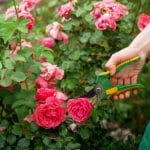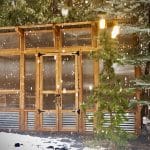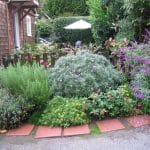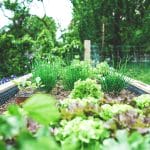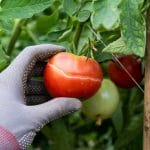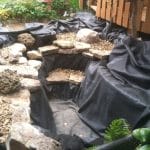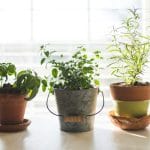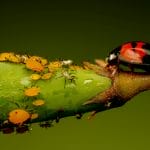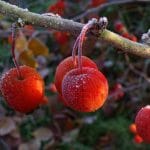The Complete Guide to Pond Plants: Types, Care & Seasonal Tips
Guides Ponds & Water Features
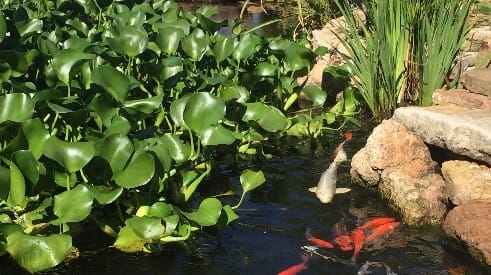
A friendly, practical guide to water plants—types, planting, care, climate survival, when to add them, where to buy, and koi-safe picks—written from years of tinkering at the water’s edge.
When I first set up a pond, I thought water + pump = done. Then summer hit. Algae got bold. The fish looked for shade. That’s when I learned what every pond keeper learns sooner or later: plants make the pond. They filter, cool, hide, feed, and frankly—make the whole thing worth staring at with a cup of coffee.
Below is Everything I wish I had in one place: what to plant, when to plant it, how to keep it alive in winter, and where to find good stock without getting burned.
What type of plants are found in ponds?
Pond plants fall into four buckets. A good pond uses a mix, like building a salad that actually fills you up.
- Marginal plants (edge dwellers): Roots in shallow water; stems and flowers above the surface. Think cattails, pickerel rush, Louisiana/Japanese irises. Great for vertical texture and water polishing. (Illinois Extension, Aggie Horticulture)
- Floating plants (free floaters): Sit on the surface, roots dangling. Water hyacinth, water lettuce, duckweed. Fast shade; thin them when they party too hard.
- Submerged plants (oxygenators): Live fully underwater—hornwort, anacharis/elodea, vallisneria. They slurp up nutrients that algae want, and give fish cover. (OSU Extension)
- Floating-leaved (rooted deep): Water lilies and lotus. Leaves float (lotus often lifts them), flowers steal the show, surface shade keeps water cool. (Southern Living)
Why this mix matters: Shade + nutrient uptake + habitat = clearer water and calmer fish.
What are the easiest pond plants to grow?
If you’re new, start simple:
- Hardy water lilies — forgiving, reliable bloomers; plant in a wide, heavy pot with loam and top with pea gravel.
- Hornwort — toss it in; it’ll find its place.
- Pickerel rush — sturdy, pollinator-friendly, tolerates a range of water levels.
- Water hyacinth (where legal) — fast shade in warm months, but check state rules; it’s invasive in some regions.
Beginner rule: Aim for about ⅓ surface coverage with leaves/floaters once established. Less than that, and algae try to run the show; more than that, and gas exchange gets tight for fish.
What are the best submerged plants for ponds?
These are your underwater janitors and fish nurseries:
- Hornwort (Ceratophyllum demersum) — free-floating or loosely anchored; great for beginners.
- Anacharis (often sold as Elodea/Egeria densa) — classic oxygenator.
- Vallisneria (eelgrass) — tall, ribbon leaves; nice backdrop.
Plant in baskets with gravel or weight bunches and let them anchor. The win here isn’t flowers—it’s nutrient uptake that levels out algae pressure.
What are the common names of aquatic plants?
Common names get slippery; here’s a quick cross-check:
- Water lily — Nymphaea
- Lotus — Nelumbo nucifera
- Hornwort — Ceratophyllum demersum
- Anacharis/Elodea — Egeria densa (often labeled “Elodea”)
- Vallisneria (eelgrass) — Vallisneria spp.
- Water lettuce — Pistia stratiotes
- Water hyacinth — Eichhornia crassipes
- Pickerel rush — Pontederia cordata
- Cattail — Typha spp.
- Parrot’s feather — Myriophyllum aquaticum (invasive in many areas)
Floating Flowering Plants
When people picture a pond, they usually imagine lilies or lotus in bloom — but flowering aquatic plants can be more than just a centerpiece. They also shade fish, help balance the water, and bring in pollinators like dragonflies and bees. Here are some pointers on flowering pond plants, with a few extras you won’t always hear.
Most floating plants don’t put on big blooms like lilies, but water hyacinth is the exception. It sends up spikes of lavender flowers in summer, and when kept in check, it adds both beauty and natural filtration.
Tips you might not know:
- In koi ponds, floaters often need floating rings or protectors to stop the fish from chewing them to bits.
- If your filtration is strong and the water is “too clean,” floaters can starve for nutrients. A light dose of phosphate-free aquatic fertilizer helps keep them growing.
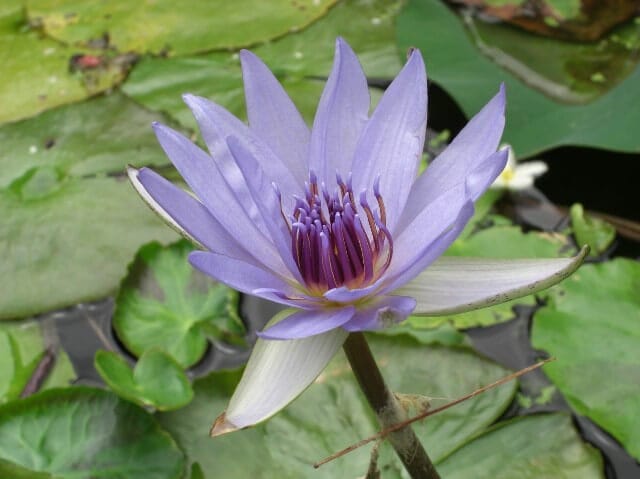
Marginal Bloomers
Many marginals aren’t just foliage — they flower, too, especially in warm months. Pickerel rush (purple spikes), water cannas (bright tropical blooms), and lizard’s tail (white, spiky flowers) all add color along the pond’s edges.
Planting trick: if your pond shelves are uneven, use mesh planting bags or tuck them into floating planters so they don’t topple into deeper water.
Water Lilies
Hardy lilies are the steady performers, flowering from late spring through fall. Colors range from white to pinks, reds, yellows, and even bronze. Tropical lilies often have more striking colors and can even bloom at night.
What often gets overlooked:
- Lilies do best in aquatic baskets, not directly in gravel. Left unchecked, they’ll spread until they crowd out everything else.
- Divide lilies every few years. Skip this step and you’ll eventually be wrestling pads and roots for hours.
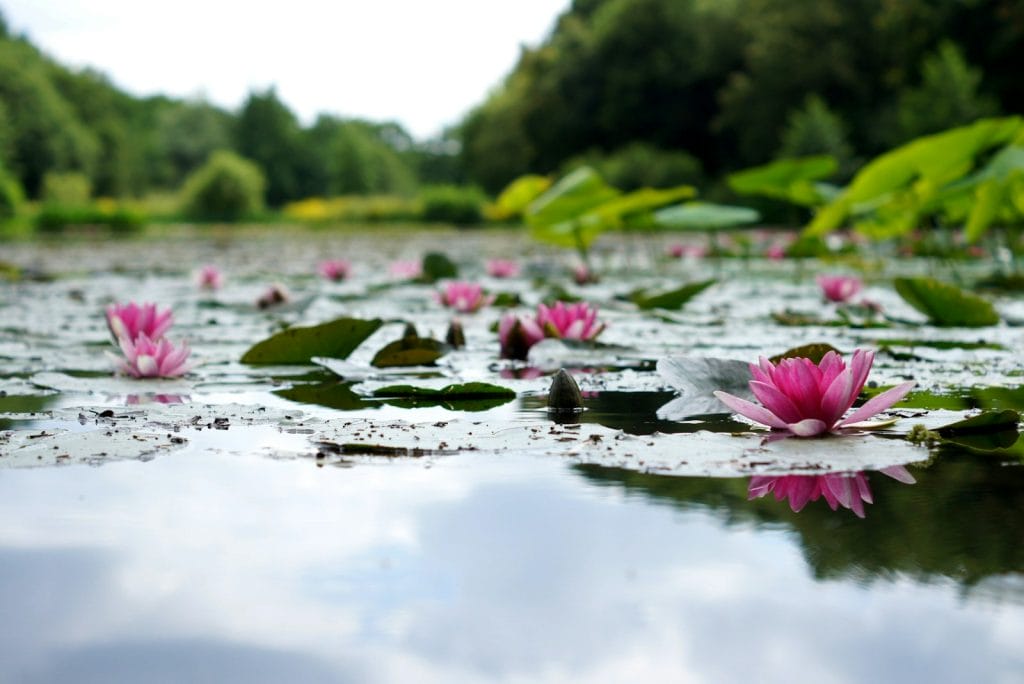
Lotus
Lotus are bold, architectural, and once they settle in, almost unstoppable. Their flowers are large, fragrant, and come in shades of pink, white, or yellow. Even dwarf varieties feel dramatic.
Care reminder: lotus tubers can rot if frozen solid. In colder zones, sink them deeper or overwinter them in a garage or basement.
Fertilizing Flowering Pond Plants
When you’re growing lilies or lotus for flowers, fertilizer makes a difference. But it’s easy to overdo it and trigger algae.
- Use low- or no-phosphate fertilizer tabs.
- Fertilize only during the growing season.
- If you’re feeding multiple lilies at once, consider pairing with a phosphate remover to avoid green water.
What are the best water plants for a small pond?
Small pond = pick plants that mind their manners.
- Dwarf or small-variety water lilies — still bloom, don’t overrun.
- Compact irises — color at the edge without a takeover.
- Parrot’s feather (where allowed) — frilly texture; trim often.
- A little duckweed — tiny floater; scoop weekly so it doesn’t carpet the world.
Container ponds and whiskey barrels do best with one lily, one marginal, one small oxygenator, and a light sprinkle of floaters.
What is the flower that floats on water?
You’re thinking water lily. Hardy lilies handle real winters; tropical lilies want warm water and long summers. Lotus is the drama queen—big leaves, big blooms—but needs heat to show off. For planting depth and care, most lilies like about 12–18 inches of water over the crown once established, in still water and full sun; fertilize monthly in the growing season.
What are the best floating plants for a koi pond?
Koi are lovable bulldozers. They’ll chew roots and redecorate your shelf plants. Use sturdy floaters and protect roots:
- Water lettuce (Pistia) — big rosettes, great summer shade.
- Water hyacinth (Eichhornia) — fast; pretty blooms; check legality first.
- Frogbit and salvinia — smaller leaves; easy to corral in a ring.
Pro move: Use floating rings, plant baskets, or a protected “plant zone” so koi can’t shred roots in five minutes.
When to add plants to a pond
Spring to early summer is the sweet spot—water has warmed, plants root faster, and you’ll get real growth before fall. Starting a brand-new pond? Give the water a couple of weeks of pump/filtration run-in (and a test for chlorine if you filled from the tap) before you pot and place.
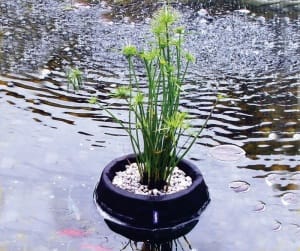
How to grow them (quick, practical planting)
- Soil: Use heavy topsoil or aquatic loam, not fluffy potting mix (it floats and fouls).
- Containers: Wide aquatic baskets for lilies/lotus; solid pots lined with burlap work too.
- Top the soil with pea gravel so fish don’t dig; it also keeps soil from escaping.
- Fertilizer: Push aquatic fertilizer tabs into the pot monthly in the warm season (skip late fall so plants can slow down for winter).
- Submerged bunches: Weight lightly; don’t bury soft stems.
- Floaters: Just set them in and thin by hand.
Which pond plants are perennial vs. annual?
Here’s the piece most people wish they understood the first year.
Hardy (Perennial) Pond Plants — the keepers
They go dormant in winter and come back when the water warms.
- Hardy water lilies — tubers rest safely at depth.
- Lotus — perennial in roughly Zone 7+ outdoors; below that, protect the tuber.
- Irises, cattails, rushes, pickerel rush — tough edge plants that shrug off frost.
Cold-season tip: In real winters, sink lily/lotus pots to the deepest shelf before ice forms so the tubers don’t freeze solid. If the tops look dead—good. That’s dormancy doing its job.
Tropical (Annual) Pond Plants — the summer guests
They look amazing from June to September, then the first frost says goodbye.
- Tropical water lilies — larger, sometimes night-blooming; tender.
- Water hyacinth, water lettuce — great shade; not winter hardy.
- Papyrus — architectural, but hates frost.
- Lotus in colder zones — treat like a tender if your winters bite.
Legality/invasives: Some floaters (hyacinth, salvinia) are restricted. Always check state rules or your extension office before you buy. (Penn State Extension)
USDA Zone-by-Zone Pond Plant Survival Cheat Sheet
Quick reference for what typically overwinters outdoors, what to treat as annuals, and a practical note for each zone.
| USDA Zone | Will Overwinter Outdoors | Likely Annuals (replace/overwinter indoors) | Notes |
|---|---|---|---|
| 3–4 | Hardy lilies, irises, cattails, rushes, pickerel rush | Tropical lilies, hyacinth, lettuce, papyrus, lotus (usually) | Sink lilies 2–3′ if possible in deep-freeze areas. |
| 5–6 | Same as above; some lotus survive if planted deep | Most floaters and tropical lilies | Store tropical lily tubers indoors if you want to keep them. |
| 7–8 | Hardy lilies, lotus, most marginals | Floaters may die back | Some tropical lilies may overwinter in mild winters. |
| 9–10 | Almost everything | Floaters only in extreme cold snaps | Mix hardy + tropical freely; thin aggressively. |
| 11+ | Everything | Rarely any | Growth doesn’t stop—stay on top of pruning. |
Not sure of your zone? Find it on the official USDA Plant Hardiness Map (enter your ZIP): Check your USDA zone.
Tropical lilies (tubers):
- Lift the pot after cool nights, slow growth.
- Rinse gently, locate the firm tuber.
- Store in damp sand or peat in a bag/tub at ~50–60°F, a dark place.
- Don’t let it dry to a rock or sit in a swamp—slightly damp is the goal.
- (Colorado State’s PlantTalk has a simple, workable approach.) (PlantTalk Colorado)
Lotus (in cold zones):
- If shallow, bring the pot into a garage/basement above freezing; keep soil just damp.
- Return outside when the water warms for spring growth.
Floaters (hyacinth, lettuce):
- Tricky but possible: shallow tote + aquarium light.
- Expect survival, not beauty; many folks just buy fresh in spring.
Papyrus:
- Pot and treat like a houseplant by a sunny window; keep soil consistently damp.
Caring for pond plants year-round
- Fertilize lilies/lotus monthly in warm months; stop late season so they’ll slow naturally.
- Trim yellowed pads and spent blooms—keeps water cleaner and plants blooming. (Better Homes & Gardens)
- Divide overgrown lilies/irises every couple of years for better blooms.
- Net in fall if trees rain leaves—decay eats oxygen and feeds algae.
- Winter oxygen exchange: In freeze country, maintain a small open hole with a de-icer or aerator so gases can escape; full ice cover + no gas exchange = fish trouble. (Ag & Natural Resources College)
Where to buy pond plants (without duds)
- Local nurseries/water-garden specialists — best for seeing plant quality in person.
- Reputable online water-garden vendors — order by scientific name; check size at maturity.
- Pond clubs & swaps — budget-friendly divisions, plus advice you can’t buy.
Quick check before you click: Make sure the plant is hardy for your zone and legal where you live; extension pages flag common invasives sold online.
Climate and depth notes (practical, not fussy)
- Depth for plant health & fish comfort: In my experience—and echoed by many builders—keeping general garden ponds around 20 inches to ~3 feet stabilizes temperature swings and makes life easier on goldfish. True koi setups benefit from going deeper in cold regions.
- Winter fish care basics: Cold water slows digestion. Feed lightly as temps fall; many keepers stop feeding around 50°F and let fish cruise through winter on reserves. Keep a vent open in the ice for gas exchange.
Pond Plant FAQ
What are the easiest pond plants for beginners?
Hardy water lilies, hornwort, and pickerel rush. They’re tough, forgiving, and useful.
When should I add pond plants?
Spring into early summer. If the pond is brand-new, give it a couple of weeks to settle and get the pump/filters running first.
How deep should I plant water lilies?
Start them shallower while they establish, then set the most hardy varieties with about 12–18 inches of water over the crown in still, sunny water.
Do I need submerged “oxygenator” plants?
You don’t need them, but they help—submerged plants absorb excess nutrients and compete with algae.
Will my plants survive winter?
Hardy lilies, irises, rushes, and pickerel rush usually do if their crowns/tubers don’t freeze solid. Tropicals like hyacinth, lettuce, and tropical lilies die back with frost unless overwintered indoors. For specific varieties, check your USDA zone.
Do I have to worry about invasive plants?
Yes. Some popular floaters are restricted. Check your state or local extension guidance before buying, and never dump pond plants into natural waterways.
Share this post
Table of Contents
- What type of plants are found in ponds?
- What are the easiest pond plants to grow?
- What are the best submerged plants for ponds?
- What are the common names of aquatic plants?
- Floating Flowering Plants
- Marginal Bloomers
- Water Lilies
- Lotus
- Fertilizing Flowering Pond Plants
- What are the best water plants for a small pond?
- What is the flower that floats on water?
- What are the best floating plants for a koi pond?
- When to add plants to a pond
- How to grow them (quick, practical planting)
- Which pond plants are perennial vs. annual?
- Hardy (Perennial) Pond Plants — the keepers
- Tropical (Annual) Pond Plants — the summer guests
- USDA Zone-by-Zone Pond Plant Survival Cheat Sheet
- Caring for pond plants year-round
- Where to buy pond plants (without duds)
- Climate and depth notes (practical, not fussy)
- Pond Plant FAQ
All categories
More From The Garden
Disclosure: This post may contain affiliate links. That means if you click and buy, The Bright Garden may earn a small commission, at no extra cost to you. We only recommend products we’ve vetted and believe will benefit our readers.

